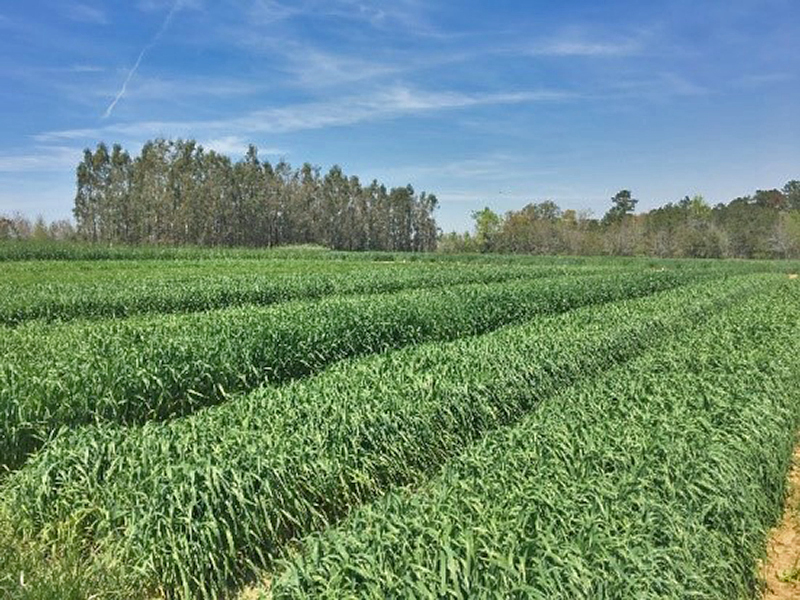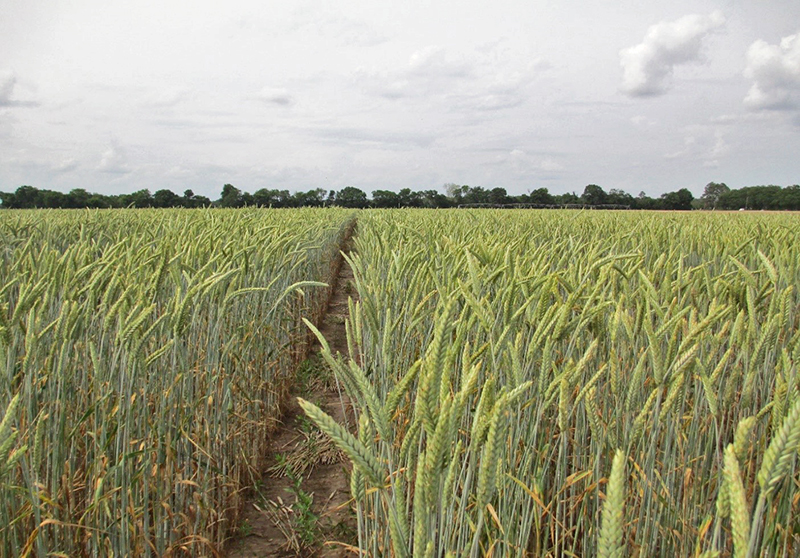Rye
Dairymen in the southern Coastal Plain utilize cereal rye as a dairy silage crop. Beef cattlemen also depend on cereal rye for cold tolerant winter forage, and often use it in blends with other winter forages, particularly with ryegrass. The digestibility when grazed early and the forage productivity are comparable to that of oat, additionally, is very tolerant of droughty and lower fertility soils.
Cereal rye (Secale cereale L.) is a cross-pollinated small grains crop. Recurrent selection is the common method for crop improvement. Cereal rye breeding is a long-term process and requires dependable forage variety testing to measure plant breeding progress. Simultaneously with selection for improved forage yields, grain production needs to be comparable to commercial cultivars to keep any new cultivar competitive for seed production and, ultimately, seed pricing. There is commercial interest in developing new cereal rye cultivars for the Southeastern U.S. This fall, UF-IFAS released two new cereal ryes, a full-season and an early cultivar that fit well into our need for improved commercial cool-season forages.

Demonstration plots of FL 2X 405 (Left) and FL 2X 406 (right) showing relative height differences, NFREC-Quincy, 2017. Credit: Ann Blount, UF/IFAS
FL 2X 405 is an early maturing, high tillering, leafy selection made from 5 cycles of recurrent selection from FL401 cereal rye for low vernalization, leafiness, early forage and grain production, and reduced incidence of Bipolaris sorokiniana (formerly called Helminthosoporium) and Puccinia recondita. FL 401 was released by the Institute of Food and Agricultural Sciences in 1985 and is still commercially popular as the earliest growing and maturing cereal rye on the Southeastern market. FL 2X 405 will replace FL401 for use as an early grazing forage, early silage producer, for windbreaks and as an early cover crop. Its leafier phenotype during the vegetative stage will provide a superior forage-type as compared to the stemmier FL 401. This will also improve its use as a cover crop because of its leafier nature, which will provide better cover of the soil when crimped and rolled in conservation tillage systems. This experimental line has performed very well in regional variety trials across the southern Coastal Plains. FL 2X 405 cereal rye was developed by the University of Florida Forage Breeding Program and was release under the SUNGRAINS cooperative small grain breeding program (among six Southern Universities) this fall.
FL 2X 406 is an ideal rye for season-long forage production, competing very well in regional variety testing in the Southeastern US. FL 2X 406 is the result of 5 cycles of recurrent selection intercrossing based on an original population comprised of well-adapted southern cereal rye varieties. FL 2X 406 cereal rye was selected for low vernalization, high tillering, full-season forage production, improved leaf rust resistance to Bipolaris sorokiniana and Puccinia recondita. Like FL2X 405, FL 2X 406 was released by UF-IFAS this fall.
–
Triticale
Triticale is increasingly sought after in the Southeastern U.S. as a forage and silage crop. Triticale is a man-made cross between wheat and rye. This well-adapted plant has a long plant breeding history in the state; however, it remained under-utilized until recently. Since the plant has both rye and wheat as its parents, it benefits from having the disease resistance of rye, coupled with the seed and forage quality of wheat. Triticale is more cold tolerant than oat, and rarely suffers the freeze damage often associated with oat plantings. Triticale also has excellent rust and good Barley Yellow Dwarf Virus (BYDV) resistance, two diseases that often reduce oat yields.
Since the early 1970s, University of Florida has managed a triticale-breeding program. The initial emphasis was directed at breeding grain types. The most active triticale breeding programs are now located at the University of Florida, North Carolina State University, and Syngenta. Past cultivars that were well-adapted to the Southeastern United States were developed by crossing durum wheat with adapted cultivars of spring rye. Three spring-type cultivars were released by the University of Florida from lines selected from Mexico’s CIMMYT nurseries. For many years these were the only recommended varieties for Florida, but were not widely grown. The protein content of these grain-types was about 12% with 0.40% lysine on a dry matter basis in the grain. Feeding trials with both, swine and poultry, showed that triticale grain could replace corn grain in diets with little effect on swine and poultry performance; however, little acreage in the Southeast was planted to the crop. Since the decline in the swine and poultry industries in Florida, we revisited triticale with the intent to develop more forage-types for our beef and dairy livestock enterprises.
Past cultivars released by the University of Florida and University of Georgia were selected mainly for their grain production. While triticale has been bred for its grain characteristics, it was not until recently that we began to emphasize types better suited for forage production, focusing on tillering, leafiness, and grazing tolerance.
Dairymen in the Southern Coastal Plain have adopted triticale as a dairy silage crop. Beef cattlemen are beginning to use triticale as well, in blends with other winter forages, particularly with ryegrass. The digestibility, water soluble sugars and forage productivity are comparable to that of oat and cereal rye, and triticale is tolerant of droughty and lower fertility soils. While we have not yet understood the actual chemical component in the plant responsible, recent studies have shown increased cattle weight gains when stockers grazed triticale-ryegrass versus rye-ryegrass in mixed sward pastures, as well as spikes in milk production when fed as silage to dairy cattle.
FL01143 is a new triticale variety developed by the University of Florida and Syngenta that was recently released under the SUNGRAINS cooperative small grain breeding program. FL01143 has considerable potential for forage and grain in the Southern U.S. FL01143 has been tested in regional and state clipping (forage), silage and grain trials. FL01143 has performed comparably well to the leading triticale forage cultivars, “Trical 342” and “Monarch” in regional and state testing. FL01143 is an upright type triticale with early season growth and good tillering capacity. It is tall in height, has early maturity, good grain yield and test weight, and has excellent disease resistance. It has performed well in both, forage and grain, trials and is well adapted to the Southern Coastal Plain region. It is unique in that it is awnless, a trait that is desirable for grazing, hay and silage production. Exclusive marketing rights were awarded to Northern Seed, and this triticale is now on the commercial market as TriCal 1143.
FL 08128 is a novel bronze chaffed triticale cultivar for silage, grazing, wildlife, or as a cover crop. FL 08128 is a new triticale (X Triticosecale) variety developed by the University of Florida and is proposed for release under the SUNGRAINS cooperative small grain breeding program. We consider FL 08128 to be a good forage type triticale, because of its early season growth and good tillering capacity. It is tall, early maturing, has good grain yield, excellent test weight, bronze chaffed, and has good disease resistance. This is the first bronze chaffed triticale released by UF/IFAS. It has performed well in both grain and forage trials, and is broadly adapted to the Southeastern U.S. FL 08128 has considerable potential for forage, grain, conservation tillage, and wildlife purposes in the Southern U.S. Exclusive marketing rights for FL 08128 will be available for licensing shortly.
–
Oat
FLLA09015-U1 is a new winter oat variety that was co-developed by the University of Florida and Louisiana State University Agricultural Center (LSUAC) and was released this fall under the SUNGRAINS cooperative. FLLA09015-U1 was developed using selected bulk breeding methods. The line was evaluated in preliminary, advanced, regional, and state grain and forage yield trials from 2015 to 2019. It is a mid-maturing, medium to mid-tall height with excellent grain yield, and very good forage yield and test weight. It has excellent crown rust resistance and very good resistance to Barley Yellow Dwarf Virus (BYDV) and stem rust, as well as demonstrating good lodging resistance. It has performed very well in both grain and forage trials, and is broadly adapted to the South and Southeastern U.S. We consider FLLA09015-U1 to be a good dual-purpose type oat because of its vigorous growth, high tillering capacity, and high grain yield potential. FLLA09015-U1 has considerable potential for forage, grain, and conservation tillage purposes in the Southeastern US.
FL0717-R2 is another winter oat variety that was co-developed by the University of Florida (UF/IFAS) and Louisiana State University Agricultural Center (LSUAC) and was released under the SUNGRAINS cooperative small grain breeding program this fall. FL0717-R2 has considerable potential for forage and grain yield outside of the U.S., including countries in South America and Southern Africa. We consider FL0717-R2 to be a good forage-type oat, because of its vigorous growth and high tillering capacity. It is medium in height, early maturating, has good grain yield, good test weight, and is crown rust resistance to prevalent races of this rust in the U.S. and in South America While there are no current plans to release this oat in the U.S., this option will be considered in the future.
–
Seed for the new releases from Fall 2019 should become available within a year. We will update you as to their commercial names and availability in our annual Cool-Season Forage Recommendations on UF/IFAS publication site called, EDIS.
- Cool-Season Forages – A Pasture Perspective for 2022 - September 16, 2022
- Ornamental Rhizoma Perennial Peanut for Groundcover or Alternative Turf - March 18, 2022
- 2021 Cool-Season Forage Recommendations for Livestock and Wildlife - September 24, 2021



